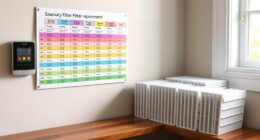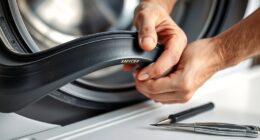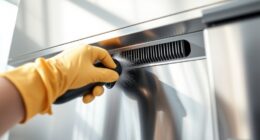Did you know that by properly maintaining your kitchen appliances, you can increase their lifespan by up to 50%?
As homeowners who aspire to master the art of appliance care, we understand the importance of preventive maintenance. By following these 7 best tips, you can keep your kitchen appliances running smoothly and efficiently for years to come.
- Regular interior cleaning
- Scheduling professional maintenance
- Inspecting filters and condenser coils
- Cleaning seals and gaskets
- Testing temperature settings
- Maintaining proper ventilation
- Using appliances according to manufacturer guidelines
Don’t let neglect shorten the life of your beloved appliances. With these preventive measures, you can ensure they serve you well and continue to be a valuable asset in your kitchen.
Key Takeaways
- Regularly clean the interior and exterior surfaces of kitchen appliances to remove dirt, stains, and grease buildup.
- Inspect and clean filters regularly to trap dirt, grease, and particles, and replace damaged or worn-out filters promptly.
- Regularly inspect and clean condenser coils to improve appliance efficiency, using a vacuum cleaner or brush to remove dirt and debris.
- Ensure proper ventilation and airflow around appliances by cleaning ventilation openings and ducts, using range hoods and exhaust fans effectively, and removing any obstructions or blockages.
Clean the Interior Regularly
How often should we clean the interior of our kitchen appliances? Regular cleaning of the interior is essential to maintain the efficiency and longevity of our kitchen appliances. To ensure optimal performance, it’s recommended to clean the interior of our appliances at least once a month, or more frequently if necessary.

When cleaning the interior, it’s important to start by unplugging the appliance and removing any detachable parts such as shelves or racks. Using a mild detergent or a specialized appliance cleaner, wipe down the interior surfaces, paying special attention to areas where food residue may be present. Carefully remove any stubborn stains or grease buildup using a soft cloth or sponge.
Additionally, it’s crucial to clean the exterior of our appliances regularly. This not only ensures a clean and presentable appearance but also prevents the accumulation of dirt and grime that can affect performance. Wipe down the exterior surfaces using a damp cloth and a mild cleaner, being cautious not to damage any electronic components.
Schedule Professional Maintenance Annually
We schedule professional maintenance for our kitchen appliances annually to ensure their optimal performance and longevity. While regular cleaning and maintenance can help prevent common issues, professional inspections are crucial for identifying potential problems that may not be visible to the naked eye. One such issue is a silent water leak, which can cause significant damage to appliances and surrounding areas if left undetected. By scheduling professional maintenance annually, we can address any potential water leaks promptly and avoid costly repairs or replacements.
During a professional maintenance visit, trained technicians thoroughly inspect all components of our kitchen appliances, including the water supply lines and drainage systems. They use specialized tools and equipment to detect any signs of water leaks or damage. If a silent water leak is detected, the technician will promptly address the issue, fixing appliance water leaks to prevent further damage.

To illustrate the importance of annual professional maintenance, consider the following table:
| Problem | Consequence |
|---|---|
| Silent water leak | Damage to appliance and surrounding areas |
| Ignored maintenance | Reduced performance and increased risk of breakdown |
| Delayed repairs | Costly repairs or replacements |
Check and Clean the Filters
First, regularly inspect and clean the filters in our kitchen appliances. Filters play a crucial role in maintaining the efficiency and longevity of our appliances, as they trap dirt, grease, and other particles that can clog the system. By inspecting the filters periodically, we can ensure that they’re in good condition and functioning properly.
To inspect the filter, start by locating it in the appliance. It could be in the range hood, dishwasher, or refrigerator. Remove the filter according to the manufacturer’s instructions. Examine it closely for any signs of damage or excessive dirt buildup. If the filter is damaged or worn out, it’s important to replace it promptly to avoid any potential issues.
Cleaning the filter is equally important. Depending on the type of filter, it can be cleaned by rinsing it under running water, using a brush to remove stubborn dirt, or using a vacuum cleaner to remove dust. Ensure that the filter is completely dry before reinstalling it.
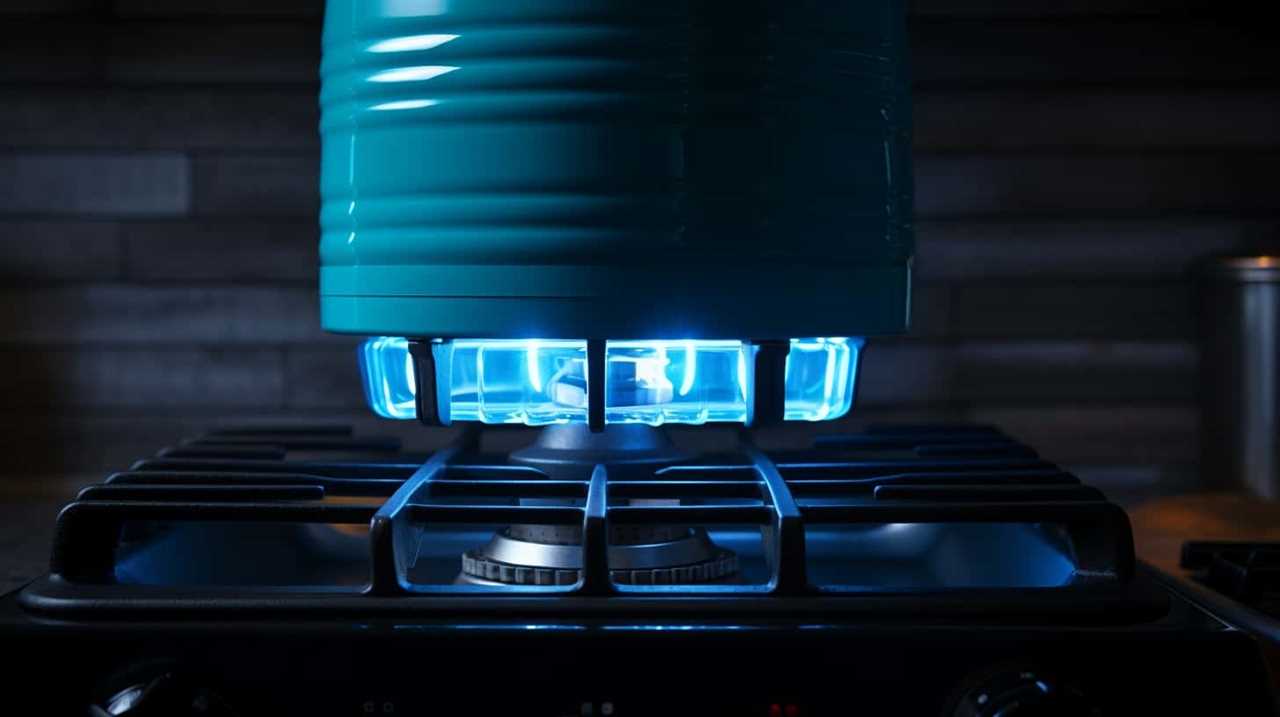
Regularly inspecting and cleaning the filters in our kitchen appliances not only improves their performance but also extends their lifespan. By replacing filters when necessary and keeping them clean, we can ensure that our appliances continue to operate efficiently and effectively.
Inspect and Clean the Condenser Coils
Continuing with our maintenance routine, let’s now turn our attention to inspecting and cleaning the condenser coils. Maintaining the condenser coils is crucial for the proper functioning and longevity of your kitchen appliances. The condenser coils are responsible for removing heat from the refrigeration system, allowing it to cool down and keep your food fresh. Over time, these coils can accumulate dirt, dust, and debris, affecting their efficiency.
Regular inspection and cleaning of the condenser coils are essential to ensure optimal performance. One of the signs of dirty condenser coils is when your refrigerator or freezer starts to run for longer periods or struggles to maintain the desired temperature. This is because the buildup on the coils prevents them from dissipating heat effectively, causing the compressor to work harder and consume more energy.
To clean the condenser coils, start by unplugging the appliance and locating the coils. They’re usually located at the back or bottom of the appliance behind a grille or panel. Use a vacuum cleaner with a brush attachment or a soft brush to gently remove the accumulated dirt and debris. Be careful not to bend or damage the delicate fins on the coils. For stubborn dirt, you can use a coil cleaning solution, following the manufacturer’s instructions.

Clean the Seals and Gaskets
Now let’s move on to maintaining the seals and gaskets for optimal kitchen appliance performance.
The seals and gaskets in your kitchen appliances play a crucial role in keeping them working efficiently and preventing any leaks or moisture buildup. To ensure the longevity of your appliances, it’s important to regularly clean and maintain these essential components.
When it comes to refrigerators, cleaning the seals is essential for maintaining the temperature and preventing any air leakage. Over time, dirt, dust, and food particles can accumulate on the seals, causing them to lose their effectiveness. To clean the refrigerator seals, simply wipe them down with a mild detergent and warm water. Be sure to thoroughly dry them afterward to prevent any moisture buildup.
In terms of maintaining the dishwasher, the gaskets are responsible for keeping the water from leaking out during the cleaning cycle. To maintain these gaskets, it’s important to regularly inspect them for any signs of wear or damage. If you notice any cracks or tears, it’s best to replace them immediately to avoid any potential leaks.
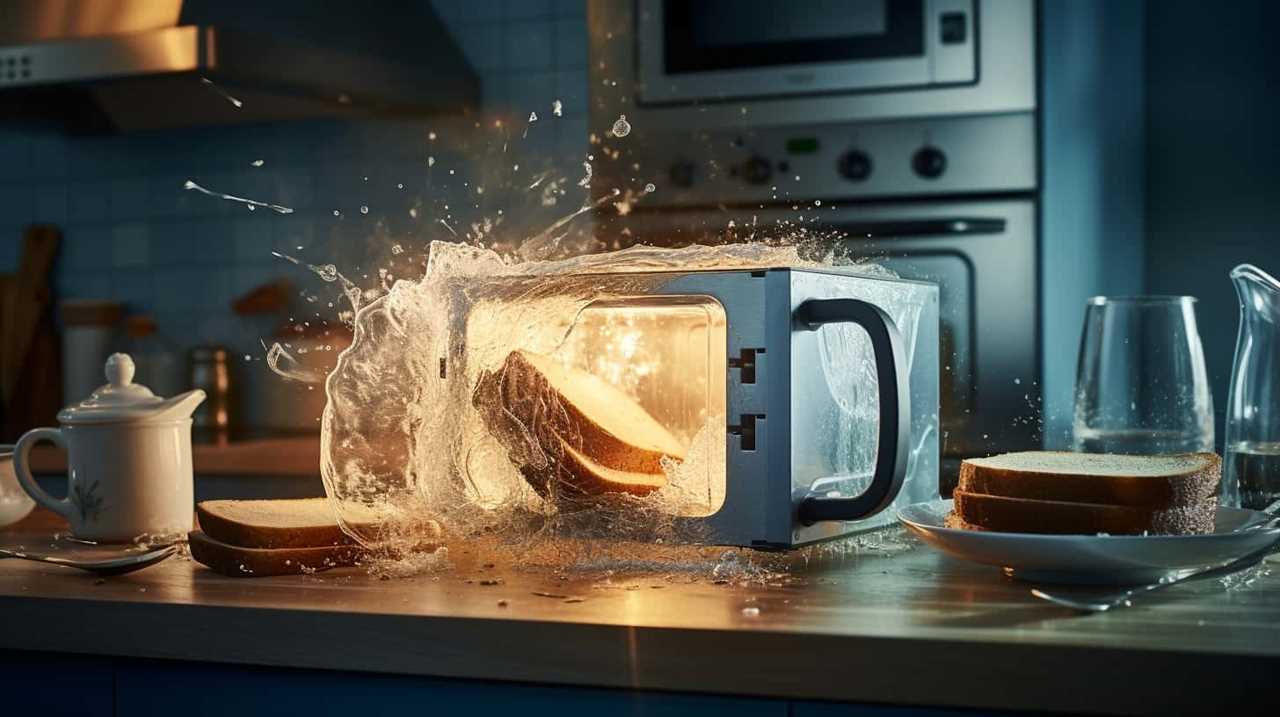
By regularly cleaning and maintaining the seals and gaskets of your kitchen appliances, you can ensure their optimal performance and prevent any issues down the line.
Now, let’s move on to the next section, where we’ll discuss how to keep your appliances free from debris.
Keep Appliances Free From Debris
To ensure the optimal performance of our kitchen appliances, we need to keep them free from debris. Over time, dirt, dust, and food particles can accumulate on the surfaces and components of our appliances, leading to decreased efficiency and potential malfunctions. Here are some cleaning techniques to help keep your appliances debris-free and functioning at their best:
- Regular wiping: Use a damp cloth or sponge to wipe down the exteriors of your appliances, removing any visible dirt or grime. Pay special attention to areas where debris tends to accumulate, such as around knobs, buttons, and vents.
- Vacuuming: Use a small handheld vacuum or the brush attachment on your regular vacuum cleaner to remove debris from hard-to-reach areas, such as the crevices of your toaster or the coils at the back of your refrigerator.
- Cleaning solutions: For tougher stains or residue, use appropriate cleaning solutions recommended by the appliance manufacturer. Be sure to follow the instructions and avoid using abrasive cleaners that could damage the surfaces.
- Maintenance checklist: Create a maintenance checklist to remind yourself of regular cleaning tasks for each appliance. This can include tasks such as cleaning out the oven, defrosting the freezer, and descaling the coffee maker.
Lubricate Moving Parts as Needed
Regular lubrication of the moving parts in your kitchen appliances is crucial for preventing wear and tear. By lubricating these parts as needed, you can ensure smooth operation and extend the lifespan of your appliances.

Neglecting to lubricate can lead to friction, heat buildup, and ultimately, costly repairs or replacements.
Importance of Regular Lubrication
As part of our preventive kitchen appliance maintenance routine, we make sure to regularly lubricate the moving parts as needed. Regular lubrication is essential for the smooth operation and longevity of kitchen appliances. Here are some key reasons why lubrication is important:
- Reduced Friction: Proper lubrication reduces friction between moving parts, preventing excessive wear and tear. This helps to extend the lifespan of your appliances.
- Improved Efficiency: Lubrication ensures that the components of your appliances can move freely, allowing them to function at their optimal capacity. This results in improved performance and energy efficiency.
- Prevention of Rust and Corrosion: By applying lubricants to susceptible areas, you create a protective barrier that helps prevent rust and corrosion, particularly in humid environments.
- Quieter Operation: Lubrication helps to dampen noise created by moving parts, resulting in quieter appliance operation.
To effectively lubricate your kitchen appliances, follow these techniques:
- Use the appropriate lubricant recommended by the manufacturer.
- Apply the lubricant sparingly, focusing on the areas where friction occurs.
- Regularly clean and remove any debris or dirt before lubricating.
- Follow the manufacturer’s guidelines for frequency of lubrication.
Preventing Wear and Tear
We ensure the prevention of wear and tear in our kitchen appliances by regularly lubricating the moving parts as needed. This simple maintenance practice not only keeps our appliances running smoothly, but it also plays a crucial role in preventing rust formation and extending their lifespan.

Moving parts such as hinges, gears, and motors can experience friction and wear down over time, leading to performance issues and potential breakdowns. By applying lubricants to these components, we reduce friction, which in turn minimizes wear and tear. The lubricants form a protective barrier that prevents rust from forming on metal parts, ensuring their longevity.
Regularly checking and lubricating these moving parts will help maintain the efficiency and reliability of our kitchen appliances for years to come.
Now, let’s move on to the next important maintenance task – checking for and repairing leaks.
Check for and Repair Leaks
When it comes to kitchen appliance maintenance, one important aspect to consider is checking for and repairing leaks.

Leaks can cause significant damage to your appliances and even your kitchen itself if left unattended.
Whether it’s a silent water leak or a visible one, it’s crucial to address the issue promptly to avoid costly repairs and potential safety hazards.
Silent Water Leak
To prevent any potential damage from a silent water leak, it’s important to regularly check for and repair leaks in your kitchen appliances. A silent water leak can go unnoticed for a long time, causing significant water damage and potentially leading to costly repairs.
Here are some tips to help you prevent water damage from silent leaks:

- Inspect the water supply lines: Regularly check the supply lines connected to your appliances, such as the dishwasher or refrigerator, for any signs of leakage or wear. Replace them if necessary.
- Check the seals and gaskets: Inspect the seals and gaskets on your appliances to ensure they’re in good condition. Damaged seals can cause water leaks, so replace them if you notice any cracks or deterioration.
- Clean the drain lines: Clear any debris or clogs from the drain lines of your appliances, as blockages can cause water to leak out.
- Install a water leak detector: Consider installing a water leak detector near your appliances. This device can alert you to any leaks and help prevent water damage.
Fixing Appliance Water Leaks
To effectively address appliance water leaks, it’s essential for homeowners to promptly check for and repair any leaks in their kitchen appliances. Detecting leaks early on can prevent further damage to the appliances and the surrounding area.
The first step is to visually inspect the appliances for any signs of water accumulation or moisture. Pay close attention to the water supply lines, hoses, and connections. If you spot any leaks or drips, it’s important to fix them immediately.
Start by turning off the appliance and shutting off the water supply. Next, tighten any loose connections or replace damaged hoses. Use a leak-proof sealant or plumber’s tape to ensure a secure fit.
Test and Calibrate Temperature Settings
We regularly test and calibrate the temperature settings of our kitchen appliances to ensure optimal performance and accurate cooking results. It’s important to maintain the accuracy of temperature settings to prevent undercooking or overcooking of food.

Here are four key steps to test and calibrate the temperature settings of your kitchen appliances:
- Use a thermometer: To test the accuracy of your oven’s temperature, place an oven-safe thermometer on the center rack and preheat the oven to a specific temperature, such as 350°F. Allow the oven to stabilize for at least 20 minutes and then check the thermometer reading. If it differs significantly from the set temperature, you may need to recalibrate the oven.
- Calibrate the oven: Consult the manufacturer’s instructions to learn how to calibrate your oven. This typically involves adjusting the oven’s temperature offset to match the actual temperature. Follow the instructions carefully to ensure accurate calibration.
- Check stove burners: To test the accuracy of your stove burners, place a small, heavy-bottomed pan filled with water on each burner and set it to a specific temperature. Use a thermometer to measure the water temperature and compare it to the set temperature. If there’s a significant difference, you may need to adjust the burner settings or replace faulty components.
- Verify refrigerator temperature: Use a refrigerator thermometer to check the temperature inside your refrigerator. It should be set to around 37°F to keep perishable foods fresh and safe. If the temperature is too high or too low, adjust the refrigerator’s temperature settings accordingly.
By regularly testing and calibrating the temperature settings of your kitchen appliances, you can ensure accurate cooking results and maintain the quality of your food.
Now, let’s move on to the next section about maintaining proper ventilation in the kitchen.
Maintain Proper Ventilation
Proper ventilation is crucial for maintaining the efficiency and longevity of kitchen appliances. Adequate airflow helps prevent overheating issues and ensures optimal performance.

Regularly cleaning the exhaust fan and filters helps remove grease and debris, preventing clogs and promoting better air circulation.
Importance of Airflow
Maintaining proper ventilation is vital for ensuring the optimal performance of kitchen appliances. Adequate airflow not only prevents the buildup of heat and odors but also contributes to the overall safety and longevity of your appliances.
Here are four key reasons why maintaining proper ventilation is essential:
- Improved Efficiency: Proper airflow allows appliances like refrigerators, ovens, and range hoods to function optimally, reducing energy consumption and saving you money in the long run.
- Enhanced Air Quality: Good ventilation helps remove smoke, fumes, and airborne particles, ensuring a healthier environment for cooking and preventing the accumulation of grease on surfaces.
- Reduced Heat Damage: Adequate airflow prevents overheating, which can lead to damage or premature failure of appliance components, such as motors or electronic circuitry.
- Prevention of Fire Hazards: Proper ventilation helps eliminate flammable gases and prevents the buildup of combustible materials, reducing the risk of fire in the kitchen.
Cleaning Exhaust Fan
To ensure proper ventilation, it’s important to regularly clean the exhaust fan. Neglecting the maintenance of your exhaust fan can lead to poor airflow and the buildup of grease and debris, which can affect the efficiency of the fan and potentially cause overheating issues in your kitchen.

To prevent these problems, it’s recommended to clean the exhaust fan at least once every three months. Start by turning off the power to the fan and removing the cover. Use a vacuum cleaner or a soft brush to remove any dust or debris from the blades and motor.
Then, wipe down the fan blades and housing with a damp cloth and a mild detergent solution. Make sure to dry it thoroughly before reassembling and turning the power back on.
Preventing Overheating Issues
How can we ensure that our kitchen appliances don’t overheat and maintain proper ventilation?
Proper ventilation is crucial for preventing electrical malfunctions and troubleshooting common overheating issues in kitchen appliances.
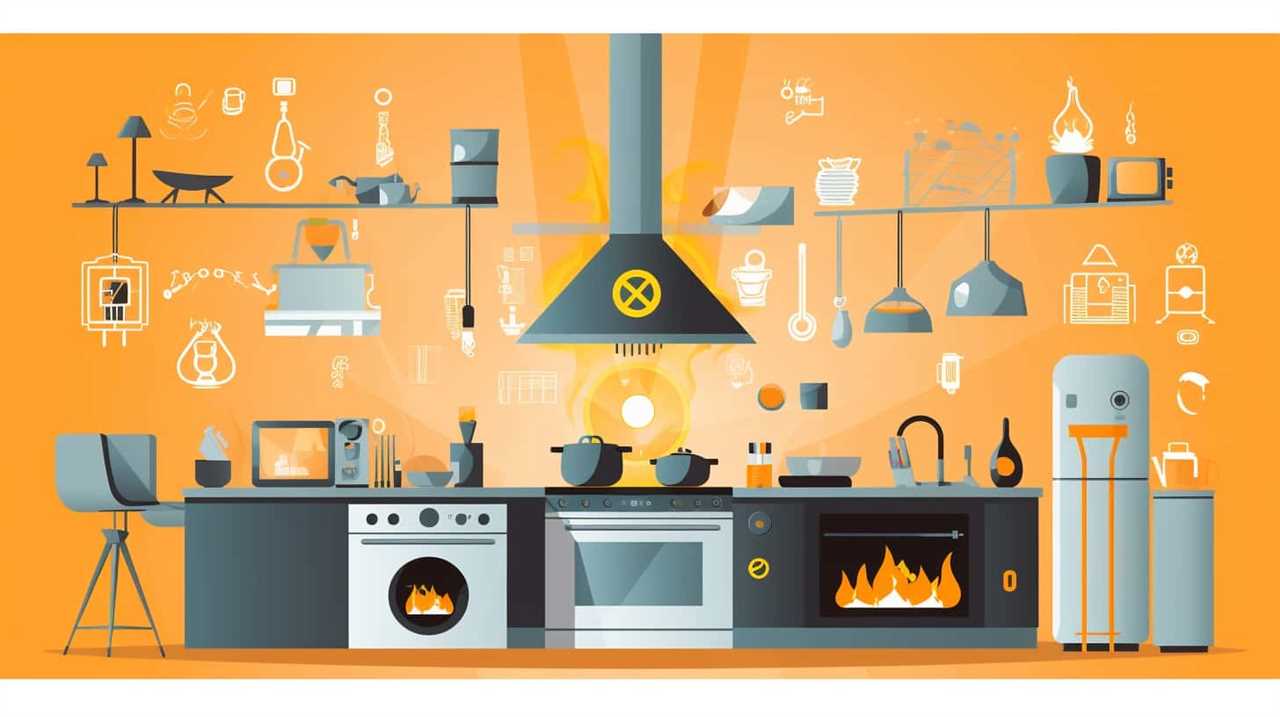
Here are some tips to maintain proper ventilation and prevent overheating:
- Clear the vents: Regularly clean the vents and remove any dirt, dust, or debris that may block the airflow. This will help the appliance to function efficiently and prevent overheating.
- Allow space around the appliance: Ensure that there’s enough space around the appliance for proper air circulation. Avoid placing appliances too close to walls or other objects that can restrict airflow.
- Check the exhaust fan: Regularly inspect and clean the exhaust fan to ensure it’s working properly. A malfunctioning exhaust fan can lead to inadequate ventilation and potential overheating.
- Regular maintenance: It’s important to schedule regular maintenance of your kitchen appliances. This includes cleaning, inspecting, and servicing them to prevent any potential overheating issues.
Use Appliances According to Manufacturer Guidelines
We should always use our kitchen appliances in accordance with the guidelines provided by the manufacturer. Following these guidelines ensures that the appliances function optimally and have a longer lifespan. Each appliance comes with specific instructions that outline the proper usage and maintenance procedures. By adhering to these guidelines, we can avoid unnecessary damage and costly repairs.
To illustrate the importance of using appliances according to manufacturer guidelines, let’s take a look at a table showcasing examples of common kitchen appliances and their corresponding guidelines:
| Appliance | Manufacturer Guidelines |
|---|---|
| Refrigerator | Do not overload the shelves. Keep the condenser coils clean. |
| Oven | Preheat the oven to the recommended temperature before cooking. Avoid using abrasive cleaning agents on the interior. |
| Dishwasher | Load dishes properly according to the provided rack configuration. Use the recommended detergent and rinse aid. |
| Blender | Do not run the blender continuously for more than the specified time. Avoid immersing the base in water. |
Store Appliances Properly When Not in Use
After using our kitchen appliances in accordance with the manufacturer guidelines, it’s important to store them properly when not in use. Proper storage is crucial for maintaining the longevity of your appliances and ensuring their optimal performance.

Here are four key points to consider when storing your kitchen appliances:
- Clean and dry: Before storing any appliance, make sure it’s thoroughly cleaned and dried. This prevents the growth of mold or bacteria and avoids any unpleasant odors. Wipe down the exterior and interior surfaces, remove any food debris, and let it air dry completely.
- Disconnect and unplug: Always disconnect your appliances from the power source before storing them. Unplug the power cord from the outlet and detach any detachable parts. This prevents any electrical accidents and helps in avoiding unnecessary power consumption.
- Use original packaging or protective covers: Whenever possible, store your appliances in their original packaging. The packaging is designed to provide maximum protection during transportation and storage. If the original packaging is unavailable, use protective covers or wraps specifically designed for the appliance to shield it from dust, scratches, and other potential damages.
- Choose a suitable storage location: Select a cool, dry, and well-ventilated area for storing your appliances. Avoid areas prone to high humidity or extreme temperatures, such as basements or attics. Additionally, ensure that the storage location is easily accessible to avoid any potential damage while moving or retrieving the appliance.
Frequently Asked Questions
How Often Should I Clean the Interior of My Kitchen Appliances?
When it comes to cleaning the interior of our kitchen appliances, we find that regular maintenance is key. It’s important to establish a cleaning routine that suits our needs and the type of appliance.
For example, ovens and refrigerators should be cleaned at least once a month, while smaller appliances like microwaves and toasters can be cleaned on a weekly basis.
Can I Clean the Filters of My Kitchen Appliances in the Dishwasher?
Yes, you can clean the filters of your kitchen appliances in the dishwasher.

It’s important to follow the dos and don’ts of cleaning kitchen appliance filters to maintain their efficiency.
Some tips for maintaining the efficiency of kitchen appliance filters include regularly cleaning them, avoiding harsh chemicals, and ensuring they’re completely dry before reinserting them.
How Do I Know if the Condenser Coils of My Kitchen Appliances Need Cleaning?
To determine if the condenser coils of our kitchen appliances need cleaning, we should look for signs of dirt and debris buildup. These may include reduced cooling efficiency, increased energy consumption, and overheating.
Regular cleaning of the condenser coils is important to ensure optimal performance and prevent damage to the appliance. By removing dirt and debris, we can improve airflow and maintain the appliance’s cooling capabilities.

It’s recommended to check and clean the condenser coils at least once a year to keep our kitchen appliances running smoothly.
What Is the Best Way to Clean the Seals and Gaskets of My Kitchen Appliances?
When it comes to cleaning the seals and gaskets of our kitchen appliances, it’s important to use the right cleaning methods. We need to be careful not to damage the seals and gaskets while cleaning them.
One common mistake to avoid is using harsh chemicals or abrasive materials that can cause them to deteriorate. Instead, we should use a mild detergent and a soft cloth to gently clean the seals and gaskets.
Regular cleaning will help maintain their integrity and ensure the optimal performance of our kitchen appliances.

How Frequently Should I Lubricate the Moving Parts of My Kitchen Appliances?
We’ve found that lubricating the moving parts of our kitchen appliances regularly is key to keeping them in top shape.
By following a maintenance schedule and checking the manufacturer’s recommendations, we ensure that we’re lubricating these parts at the right frequency.
This helps reduce friction, prevent wear and tear, and extend the lifespan of our appliances.
It’s important to stay on top of this task to avoid any unexpected breakdowns or costly repairs.

What Are the Best Tips for Preventive Kitchen Appliance Maintenance?
Preventive kitchen appliance maintenance is essential for prolonging the life of your appliances. Regular cleaning and proper usage are key to effective kitchen appliance maintenance. Check for any signs of wear and tear, and address them promptly. Conducting routine inspections and following manufacturer recommendations can help prevent costly repairs down the line.
Conclusion
In conclusion, maintaining your kitchen appliances is like tending to a well-oiled machine. By regularly cleaning the interior, filters, condenser coils, seals, and gaskets, you ensure their longevity and efficient performance.
Testing and calibrating temperature settings and maintaining proper ventilation are also crucial. Following manufacturer guidelines and storing appliances properly when not in use further contribute to their longevity.
Remember, a well-maintained kitchen is a recipe for success!








